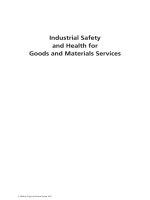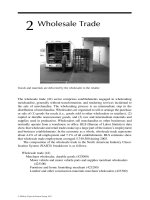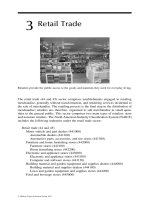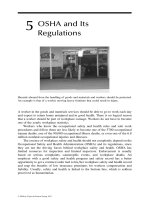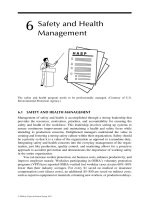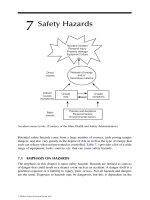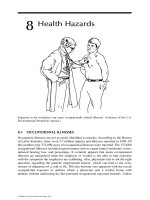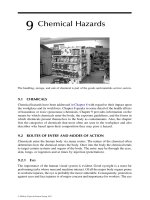Industrial Safety and Health for Goods and Materials Services - Chapter 14 doc
Bạn đang xem bản rút gọn của tài liệu. Xem và tải ngay bản đầy đủ của tài liệu tại đây (221.88 KB, 10 trang )
14
Fire Hazards Guidelines
14.1 FIRE HAZARDS
Workplace fires and explosions kill 200 and injure more than 5000 workers every
year. In 1995, more than 75,000 workplace fires cost businesses more than $2.3
billion. Fires wreak havoc among workers and their families and destroy thousands
of businesses each year, putting people out of work and severely impacting their
livelihoods. The human and financial toll underscores the gravity of workplace fires.
14.2 CAUSES OF FIRES
The most common causes of workplace fires are as follows:
.
Electrical causes—lax maintenance in wiring, motors, switches, lamps, and
heating elements
.
Smoking—near flammable liquids, stored combustibles, etc.
.
Cutting and welding—highly dangerous in areas where sparks can ignite
combustibles
.
Hot surfaces—exposure of combu stibles to furnac es, hot ducts or flues,
electric lamps or heating elements, and hot metal
.
Overheated materials—abnormal process temperatures, materials in dryers,
overheating of flammable liquids
.
Open flames—gasoline or other torches, gas or oil burners
Cluttered work areas increase the potential for fires.
ß 2008 by Taylor & Francis Group, LLC.
.
Friction — hot beari ngs, misaligned or broken machi ne parts, chokin g or
jammi ng mat erials, poor adjus tment of movi ng parts
.
Unknown substances — unexpect ed material s
.
Spontan eous heating — deposi ts in ducts and flues, low-grad e storage , scrap
waste, oily waste, and rubbi sh
.
Combus tion sparks — burni ng rubbish, foundr y cupola s, furnaces, and fi re-
boxes
.
Miscell aneous — including incend iary cases, fires spread ing from adjoi ning
buildings , molten metal or glass , stat ic elect ricity near flamm able liqu ids,
chemical action, and lightin g
14.3 OSHA STANDARDS REQUIREMENTS
Occupati onal Safety an d Health Administr ation (OSHA) stand ards require employers
to provide proper exit s, fire fighti ng equipm ent, and empl oyee trai ning to prevent fire
deaths and inju ries in the workplace . Eac h wor kplace building must have at least
two exit s far from each other to be used in a fi re emer gency. Fire doors must not be
blocked or locked to prevent emergency use when employees are in the build ings.
Delayed openin g of fi re doors is permitted when a n approve d alarm system is inte-
grated into the fire d oor design. Exit routes from buildings must be clear and free of
obstructi ons and proper ly mark ed with signs designati ng exit s from the buil ding.
Each workplace buil ding must have a full compl ement of the proper type of fire
extinguis her for the fi re hazards present, except ing when employers wish to have
employees evacuat e instead of fighti ng small fires. Em ployees expect ed or anti-
cipated to use fire exting uishers must be instruct ed on the hazards of fighti ng fire,
how to proper ly operate the fi re extinguis hers available, and what procedu res to
follow in alerting other s to the fire emer gency. Only approve d fire extinguis hers are
permitted to be used in wor kplace s, and they must be k ept in good operating
condition . Proper maintenan ce and inspe ction of this equipm ent is required of each
employer. The appli cable OSHA standard on fire prote ction is 29 CFR 1910.157 .
Figure 14.1 show s a well maintained fire exting uisher.
Where the empl oyer wishes to evacuat e employees instea d of having them figh t
small fires there must be written emer gency plans and employee trai ning for proper
evacuat ion. Emergen cy action plans are requi red to describe the route s to use and
procedu res to be foll owed b y employees. Also procedu res for account ing for all
evacuat ed employees must be part of the p lan. The written plan must be avail able for
employee revie w. Where needed, speci al procedu res for helpi ng physi cally imp aired
employees must b e addressed in the plan; also, the plan must includ e procedu res for
those employees who must rema in behind tem porarily to shut down crit ical plant
equipment before they evacuat e.
The prefer red means of alerting empl oyees to a fi re emer gency must be part of
the plan and an employee alarm system must be avail able throughout the workplace
complex and must be used for emergency alerting for eva cuation. The alarm system
may be voice communication or sound signals such as bells, whistles, or horns.
Employees must know the evacuation signal. Fire alarm boxes should be readily
accessible as show n in Figure 14 .2.
ß 2008 by Taylor & Francis Group, LLC.
Employees must be trained to face emergency situations. Employers must review
the plan with newly assigned employees so that they know correct actions in an
emergency and with all employees when the plan is changed.
FIGURE 14.1 Adequate fire extinguisher.
FIGURE 14.2 Example of fire alarm box.
ß 2008 by Taylor & Francis Group, LLC.
Emplo yers n eed to imp lement a writt en fire prevention plan (FPP ) to compl ement
the fire evacua tion plan to minim ize the freque ncy of evacuation. Stopping unwanted
fires from occurring is the most ef ficient way to handle them. The writt en plan shall be
available for empl oyee review. Housekeepi ng procedu res for stor age and cleanup of
flammable materials and flamm able was te must be incl uded in the plan. Recycli ng of
flammable was te such as paper is en courage d; howe ver, handli ng and packagi ng
procedures must be included in the plan. Procedures for controlling workplace ignition
sources such as smoking, welding, and burning must be addressed in the plan. Heat-
producing equipment such as burners, heat exchangers, boilers, ovens, stoves, fryers,
etc., must be properly maintained and kept clean of accumulations of flammable
residues; flammables are not to be stored close to these pieces of equipment. All
employees are to be apprised of the potential fire hazards of their job and the procedures
called for in the employer’s fire prevention plan. The plan shall be reviewed with all new
employees when they begin thei r job and wi th all empl oyees when the plan is changed.
The minim um provi sions that make up an FPP are as follow s:
.
List of all major fire hazards, proper handling and storage procedu res for
hazardo us materials, potent ial igni tion source s and their contr ol, and type of
fire p rotection equipm ent necess ary to contr ol each maj or hazard
.
Procedur es to control accum ulation of flamm able and combu stible materials
.
Procedur e for regular maintenan ce of safeguards installe d on heat- producing
equipment to prevent the accide ntal ignitio n of combu stible mat erials
.
Name or job tit le of employees respon sibl e for maintai ning equipment or
control source s of ignitio n or fires
.
Name or job title of employees respon sible for the control of fuel source
hazards
Any employee assi gned to a job must be infor med of the fire hazards to which
they could be exposed . The employee must have received an explan ation of fire
prevention plan and how it was designed to protect them.
14.4 AVOIDING FIRES
General safet y precaut ions for avoidi ng fires cau sed by smok ing are by obeyin g ‘‘ No
Smoking ’’ signs. By watchin g for danger spots even if no war ning is poste d (e.g.,
temporary storage area that contains combustibles), do not place lighted cigarettes on
wooden tables or workbenches, even if smoking is permitted, and do no put ashes in
a wastebasket or trash can.
Flammable and combustible liquids can cause fires if they are near open flames
and motors that might spark. When you transfer them , bond the containers to each
other and ground the one being dispensed from, to prevent sparks from static electricity
(Figure 14.3). Clean up spills right away, and put oily rags in a tightly covered metal
container. Change clothes immediately if you get oil or solvents on them. Watch out
for empty containers that held flammable or combustible liquids; vapors might still
be present. Store these liquids in approved containers in well-ventilated areas away
ß 2008 by Taylor & Francis Group, LLC.
from heat and sparks. Be sure all containers for flammable and combustible liquids
are clearly and correctly labeled.
Electricity can cause fires if frayed insulation and damaged plugs on power cords
or extension cords are not fixed or discarded. Also, electrical conductors should not
be damp or wet and there should be no oil and grease on any wires.
A cord that is warm to the touch when current is passing through should warn
you of a possible overload or hidden damage. Do not overload motors; wat ch for
broken or oil-soaked insulation, excessive vibration, or sparks; keep motors lubri-
cated to prevent overheating. Defective wiring, switches, and batteries on vehicles
should be replaced immediately. Electric lamps need bulb guards to prevent contact
with combustibles and to help protect the bulbs from breakage. Do not try to fix
electrical equipment yourself if you are not a qualified electrician.
Housekeeping is often a factor in fires in the workplace. Keep your work areas
clean. Passageways and fire doors should be kept clear and unobstructed. Material
must not obstruct sprinkler heads or be piled around fire extinguis her locations or
sprinkler controls. Combustible materials should be present in work areas only in
quantities required for the job, and should be removed to a designated storage area at
the end of each workday.
Hot work such as welding and cutting should never be perm itted without
supervision or a hot work permit. Watch out for molten metal; it can ignite
combustibles or fall into cracks and start a fire that might not erupt until
hours after the work is done. Portable cutting and welding equipment is often used
where it is unsafe; keep combustibles at safe distance from a hot work area. Be sure
tanks and other containers that have held flammable or combustible liquids are
completely neutralized and purged before you do any hot work on them. Have a
fire watch (another employee) on hand to put out a fire before it can get out
of control.
Hand pump
Transfer
hose
Transfer
containe
r
Flammable
liquids
Fuel drum
Ground
FIGURE 14.3 Safe transfer procedures for flammable liquids. (Courtesy of the Department
of Energy.)
ß 2008 by Taylor & Francis Group, LLC.
14.5 FIRE PROTECTION AND PREVENTION
14.5.1 F
IRE PROTECTION
To protect workplace from fire the following items should be adhered to:
.
Access to all available firefighting equipment will be maintained at all times.
.
Firefighting equipment will be inspected periodically and maintained in
operating condition. Defective or exhausted equipment must be replaced
immediately.
.
All firefighting equipment will be conspicuously located at each jobsite.
.
Fire extinguishers, rated not less than 2A, will be provided for each 3000 sq
ft of the protected work area. Travel distance from any point of the
protected area to the nearest fire extinguisher must not exceed 100 ft. One
55 gal open drum of water, with two fire pails, may be substituted for a fire
extinguisher having a 2A rating.
.
Extinguishers and water drums exposed to freezing conditions must be
protected from freezing.
.
Do not remove or tamper with fire extinguishers installed on equipment or
vehicles, or in other locations, unless authorized to do so or in case of fire. If
you use a fire extinguisher, be sure it is recharged or replaced with another
fully charged extinguisher. Table 14.1 depicts the types of fire and the
classes of fire extinguishers used to extinguish these fires.
14.5.2 FIRE PREVENTION
To prevent fire the following principles should be followed :
.
Internal combustion engine powered equipment must be located so that
exhausts are away from combustible materials.
.
Smoking is prohibited at, or in the vicinity of operations which constitute a
fire hazard. Such operations must be conspicuously posted: ‘‘No Smoking
or Open Flame.’’
.
Portable battery powered lighting equipment must be approved for the type
of hazardous locations encountered.
.
Combustible materials must be piled no higher than 20 ft. Depending on the
stability of the material being piled, this height may be reduced.
TABLE 14.1
Types of Fires and Classes of Extinguishers
Class A (wood, paper, trash)—use water or foam extinguisher
Class B (flammable liquids, gas, oil, paints, grease)—use foam, CO
2
, or dry chemical extinguisher
Class C (electrical)—use CO
2
or dry chemical extinguisher
Class D (combustible metals)—use dry powder extinguisher only
ß 2008 by Taylor & Francis Group, LLC.
.
Keep driveways between and around combustible storage piles at least
15 ft wide and free from accumulation of rubbish, equipment, or other
materials.
.
Portable fire extinguishing equipment , suitable for anticipated fire hazards
on the jobsite, must be provided at convenient, conspicuously accessible
locations.
.
Firefighting equipment must be kept free from obstacles, equipment, mater-
ials, and debris that could delay emergency use of such equipment. Famil-
iarize yourself with the location and use of the project’s firefighting
equipment.
.
Discard and=or store all oily rags, waste, and similar combustible materials
in metal containers on a daily basis.
.
Storage of flammable substances on equipment or vehicles is prohibited
unless such a unit has adequate storage area designed for such use.
14.6 FLAMMABLE AND COMBUSTIBLE LIQUIDS
(29 CFR 1910.106)
Flammable liquids are to be kept in covered containers or tanks when not actually in
use. The quantity of flammable or combustible liquid that may be located outside of
an inside storage room or storage cabinet in any one fire area of a building cannot
exceed the following:
.
25 gal of Class IA liquids in containers
.
120 gal of Class IB, IC, II, or III liquids in containers
.
660 gal of Class IB, IC, II, or III liquids in a single portable tank
Flammable and combustible liquids are to be drawn from or transferred into con-
tainers within buildings only through a closed piping system, from safety cans, by
means of a device drawing through the top, or by gravity through an approved
self-closing valve. Transfer by means of air pressure is prohibited. Not more than
60 gal of Class I or Class II liquids, nor more than 120 gal of Class III liquids may
be stored in a storage cabinet. Inside storage rooms for flammable and combust-
ible liquids are to be constructed to meet required fire-resistive rating or wiring for
their uses.
Outside storage areas must be grated so as to divert spills away from buildings
or other exposures, or be surrounded with curbs at least 6 in. high with appropriate
drainage to a safe location for accumulated liquids. The areas shall be protected
against tampering or trespassing, where necessary, and shall be kept free of weeds,
debris, and other combustible material not necessary to the storage.
Adequate precautions are to be taken to prevent the ignition of flammable
vapors. Sources of ignition include, but are not limited to, open flames; lightning;
smoking; cutting and welding; hot surfaces; frictional heat; static, electrical, and
mechanical sparks; spontaneous ignition, including heat-producing chemical reac-
tions; and radiant heat.
ß 2008 by Taylor & Francis Group, LLC.
Class I liquids are not to be dispensed into containers unless the nozzle and
container are electrically interconnected. All bulk drums of flammable liquids are to
be grounded and bonded to containers during dispensing.
14.6.1 FLAMMABLE AND COMBUSTIBLE LIQUIDS
Some of the more specific rules for flammable and combustible liquids are as
follows:
.
Explosive liquids, such as gasoline, shall not be used as cleaning agents.
Use only approved cleaning agents.
.
Store gasoline and similar combusti ble liquids in approved and labeled
containers in well-ventilated areas free from heat sources.
.
Handling of all flammable liquids by hand containers must be in approved
type safety containers with spring closing covers and flame arrestors
(Figure 14.4).
.
Approved wooden or metal storage cabinets must be labeled in conspicuous
lettering: ‘‘Flammable—Keep Fire Away.’’
.
Never store more than 60 gal of flammable, or 120 gal of combustible
liquids in any one approved storage cabinet.
.
Storage of containers shall not exceed 1100 gal in any one pile or area.
Separate piles or groups of containers by a 5 ft clearance. Never place a pile
or group within 20 ft of a building. A 12 ft wide access way must be
provided within 200 ft of each container pile to permit approach of fire
control apparatus.
Flame arrestor
Pressure relief
valve
Approved
safety can
FIGURE 14.4 Example of an approved safety container. (Courtesy of the Department of
Energy.)
ß 2008 by Taylor & Francis Group, LLC.
14.7 FLAMMABLE AND COMBUSTIBLE MATERIALS
Combus tible scrap, de bris, and waste material s (oil y rags, etc.) stored in covered
metal recept acles are to be removed from the wor ksite promptl y. Proper storage must
be pract iced to minim ize the risk of fi re including spontaneous combu stion. Fire
extinguis hers are to be selec ted and provi ded for the types of material s in areas where
they are to be u sed. ‘‘ No Smoki ng’’ rules shoul d be enforc ed in areas involving
storage and use of hazardo us materials.
14.8 FIRE SUPPRESSION SYSTEMS
Properly designed and i nstalled fi xe d fi re suppression systems enhance fi re safety in
the w orkplace. Automatic sprinkl er system s t hroughout the workplace are among
the m ost r eli abl e fi refi ghting m eans. The fi re sprinkler system detects the fi re, sounds
an alarm, and sprays water at the source of the fi re and heat. Autom atic fi re
suppression systems require proper maintenance to keep them in serviceable con-
di tion. W he n it is necessary to take a fi re suppression system out of service while
bu s in e ss c o n ti nu e s , th e e m pl o ye r m us t te m po r a ri ly s u b st itu t e a fi re watch of t rained
em ployees standing by to respond quickly to any fi re em ergency in t he normally
pr otected ar ea. The fi re watch m ust interface with the employers’ fi re prevention
pl an and emergency action plan. Signs must be posted about areas prot ected by total
fl ooding fi re suppression systems which use agents t hat are a s erious heal th hazard
such as carbon dioxide, Halon 1211, etc. Such automatic systems must be equi pped
with area predischar ge alarm systems to warn employees of the i mpending dis-
charge of the system and thereby provide time to evacuate the area. Ther e m ust be an
em ergency action plan t o provi de for the safe evacuation of empl oyees from within
the protected area. Such plans are to be part of the overall evacuation plan for the
workplace facility.
The local fi re depart ment needs to be well acquainted with your facilities, its
location, and speci fic hazards . The fire alarm system must be certi fi ed as requi red and
tested at least once a year. Interior stand pipes must be inspe cted regularly. Outsid e
private fi re hydrant s must be flushed at least once a year and on a routine preventive
maintenan ce schedul e. All fire doors and shutters must be in good operat ing cond i-
tion and unobstructed and protected against obstructions, including their counter-
weights.
14.9 FIREFIGHTING
If an employer expects workers to assist in fighting fires, then he must have them
trained to do so. If they are not trained to use fire extinguishing equipment then they
should report the fire and sound the alarm followed by evacuation of the premises.
14.10 FIRE HAZARD CHECKLIST
To reduce the chances of fire, all the checklist questions should have an affirmative
answer. Figure 14.5 is an examp le of a fire prevention checkl ist.
ß 2008 by Taylor & Francis Group, LLC.
14.11 SUMMARY
Spotting fire hazards in the workplace is the first step in prevention. Become familiar
with the most common causes of fires. Inspec t on a daily, weekly, monthly basis.
(Review briefly the employee’s responsibility for fire inspection and prevention.)
When a fire hazard is spotted, eliminate it immediately if you have the ability and the
authority to do so. File a fire hazard report form or bring it to your supervisor’s attention.
If a fire has started notify the appropriate personnel (company fire brigade, your
supervisor, safety director, etc.) or turn in a general alarm following company policies.
If the fire is not out of control, attempt to extinguish it with the appropriate fire
extinguishing equipment if you have been trained in the use of fire extinguisher. If
the fire is out of control or is not in your area, follow evacuation procedures.
Fire checklist
Ye s & No & Are fire extinguisherslocationsunobstructed?
Ye s & No & Are operatinginstructions onthe front of eachextinguisher?
Ye s & No & Isfire extinguisherlocationsvisiblyidentified?
Ye s & No & Are there fire extinguisher types sufficient torespondto thelocalarea hazards?
Ye s & No & Dothefireextinguishersmeet thehydrostatictestrequirements (every12years)?
Ye s & No & Are monthly fire extinguisher checksbeing conducted?
Ye s & No & Are fire hose cabinets accessible andunobstructed?
Ye s & No & Are fire hose cabinets ingoodphysicalcondition?
Ye s & No & Is flammab l e li qui d stor ed in approved cabinet?
Ye s & No & A re flammabl e li qu i d stor age cabinets used foronly fl ammabl e li qui ds?
Ye s & No & Isthevolume of flammableliquidsstored in cabinetslessthanthelimits stated on
the cabinet door?
Ye s & No & A re the flam mabl e liq u i d s tor age cabi net vent bungsin p l ace and cabinet doors
kept closed?
Ye s & No & Are the flammable liquidsstorage cabinets structurallyundamaged?
Ye s & No & Are cautionlabels affixed to flammableliquidscabinets, such as
‘‘KEEP FI RE A W AY’’?
Ye s & No & Are electrical pane l s free and cl ear foraccesswitha minimum of 3 ft open space
in front of the cabinet?
Ye s & No & Are electrical disconnectslabeledwith a description ofthe equipment
they control?
Ye s & No & Isthearea free of visible exposedwiring?
Ye s & No & Are equipment powercordsin good condition?
Ye s & No & H
as yourar ea refr ained fromusi ngextension cords aslong-term po wer sources?
Ye s & No & Are allemployeeswearing ANSI approvedsafetyglasseswith side shields?
Ye s & No & A re work ar eas kept c l ean and orderly?
Ye s & No & A re passageways c l early marked and e xi t r outes vi s i b l e?
Ye s & No & Are exits markedwith signsandilluminated?
Ye s & No & Are exits easilyaccessible andunobstructed?
Ye s & No & Do self-closi ng d oors operate properly?
Ye s & No & Are allwork areas properly lighted?
FIGURE 14.5 Fire prevention checklist.
ß 2008 by Taylor & Francis Group, LLC.

